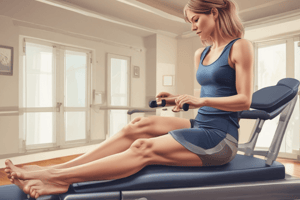Podcast
Questions and Answers
What are the two main stroke presentations?
What are the two main stroke presentations?
infarct and hemorrhage
What is a primary aim of acute physiotherapy intervention?
What is a primary aim of acute physiotherapy intervention?
- To enhance patient dietary intake
- To improve/maintain chest status (correct)
- To maintain normal blood pressure
- To reduce hospital stay duration
Which of the following are risk factors for chest infection post acute neurological injury? (Select all that apply)
Which of the following are risk factors for chest infection post acute neurological injury? (Select all that apply)
- Prolonged immobility (correct)
- Impaired respiratory drive (correct)
- Poor head/sitting posture (correct)
- Increased physical activity
Mortality of hemorrhagic stroke is lower than infarct stroke.
Mortality of hemorrhagic stroke is lower than infarct stroke.
What is the Glasgow Coma Scale (GCS) used for?
What is the Glasgow Coma Scale (GCS) used for?
Atelectasis is a complete or partial collapse of the entire lung or area (____) of the lung.
Atelectasis is a complete or partial collapse of the entire lung or area (____) of the lung.
Which statement is true regarding early mobilizing in acute stroke patients?
Which statement is true regarding early mobilizing in acute stroke patients?
What type of management plan should be developed for stroke treatment?
What type of management plan should be developed for stroke treatment?
There are no contraindications for early mobilizing stroke patients.
There are no contraindications for early mobilizing stroke patients.
What should physiotherapists be aware of when treating different stroke types?
What should physiotherapists be aware of when treating different stroke types?
Flashcards are hidden until you start studying
Study Notes
Aims of the Lecture
- Review typical movement dysfunction symptoms following a stroke.
- Describe the physiotherapist's role in acute and rehabilitation settings.
- Compare management strategies for different stroke types.
- Explain pathophysiology and treatment options for hemiplegic shoulder pain.
- Outline the essential attributes of a Stroke Unit.
Stroke Presentation
- Main types: infarct and hemorrhage (Intracerebral Hemorrhage - ICH, Subarachnoid Hemorrhage - SAH).
- Symptoms depend on damage location and extent.
- Higher mortality rates associated with hemorrhage.
- SAH patients often require surgical intervention, unlike ICH patients.
Treatment Considerations
- Knowledge of stroke anatomy and pathophysiology is essential.
- Acknowledge contraindications and follow clinical practice guidelines specific to stroke care.
Stroke Treatment Work Plan
- Gather relevant patient information.
- Ensure a safe environment before assessment.
- Prioritize assessment to accommodate patient fatigue.
- Develop and communicate management and discharge plans collaboratively with allied health professionals (AHPs).
Aims of Acute Physiotherapy Intervention
- Improve or maintain respiratory status.
- Initiate neurorehabilitation promptly.
- Normalize musculoskeletal status of immobile limbs.
- Collaborate with AHPs for discharge planning.
Risk Factors for Chest Infection Post Stroke
- Prolonged immobility and impaired respiratory functions.
- Decreased cough reflex and bulbar function impairments.
- Premorbid lung diseases, such as Chronic Obstructive Pulmonary Disease (COPD).
- Poor posture impacting respiratory efficacy.
Case Study Insights (10 Days Post SAH)
- Symptoms: Drowsiness, immobility, left hemiplegia, and depressed cough reflex.
- Increased aspiration risk due to neurological impairments.
Effects of Chest Infection
- Potential respiratory causes of increased Intracranial Pressure (ICP).
- Risks: pulmonary secretions and atelectasis (lung collapse).
- Increased levels of carbon dioxide (PCO2) can elevate ICP.
Respiratory Management Strategies
- Limited active participation may hinder traditional techniques.
- Implement manual techniques for sputum clearance and reflex cough activation.
- Promote early mobilization as a chest rehabilitation strategy.
Acute Neurorehabilitation Principles
- Implement a bed positioning regime for managing abnormal tone and at-risk joints.
- Early mobilization is encouraged within 24 hours post-stroke.
- Functional tasks should start early, including rolling and reaching exercises.
Bed Positioning Regime Goals
- Protect at-risk joints and maintain functional range of motion.
- Encourage spatial awareness of both sides of the body.
Benefits of Early Mobilization
- Reduces reliance on a sick role and improves respiratory function (increased SaO2).
- Lowers risks of pressure sores and deep vein thrombosis (DVT).
- Enhances outcomes in continence training and reduces aspiration risks.
- Improves awareness and sensory input to stimulate postural muscles.
Contraindications for Early Mobilization
- Stability issues concerning medical or neurological conditions.
- Specific factors related to neurosurgical procedures.
- Differences in considerations for mobilizing patients with infarct, ICH, or SAH based on their stability and recovery needs.
Studying That Suits You
Use AI to generate personalized quizzes and flashcards to suit your learning preferences.




